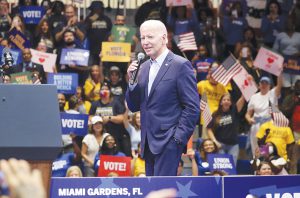Stephen Mihm
The midterms are here, and with it predictions that the nation’s economic woes will cost Democrats control of Congress. As one pundit on Fox News recently declared, political consultant James Carville’s 1992 adage, “It’s the economy, stupid,†still applies. Polling data seems to support this point of view.
But applying a 30-year-old rule of thumb for a presidential election to the 2022 midterms isn’t such a safe bet, if history has any say.
The Democrats will almost certainly lose seats, much as any party that holds the presidency tends to lose ground in the midterms. But research suggests that the economy is unlikely to affect that outcome one way or another.
This wasn’t the case in the 19th century, when economic issues often decided midterm elections. One study of the period ran regression analyses to determine whether economic growth or prices of household necessities had helped determine midterm outcomes. It found a significant correlation.
Why? The author speculated that in this earlier era, Congress, not the president, did most of the heavy lifting when it came to crafting economic policy. Before the creation of the Federal Reserve Bank, battles over monetary policy and other economic issues dominated American politics, with very clear lines dividing Democrats and Republicans.
These controversies are largely forgotten today. But for the people living in the Gilded Age, the question of the free coinage of silver, debates over the use of paper money versus coins and other monetary issues consumed the electorate and their representatives in Congress. So, too, did tariff schedules, another contentious issue that Congress largely controlled. Even federal budgets still remained firmly in the hands of appropriations committees, not the executive branch.
In short, midterm elections were an opportunity to weigh in on economic issues precisely because members of Congress played an outsize role in determining economic policy — and presidents did not. As a consequence, price levels or job growth fueled midterm turnout in ways that directly affected the outcome of these elections.
For example, voters in 1894, furious about a crippling depression, vented their fury at Congress. The Democrats, who formerly controlled the House, lost 100 seats in this election — the biggest midterm loss ever.
The 20th century brought changes that reconfigured how voters understood the relationship between Congress and the economy. The Federal Reserve Act of 1913, which began a gradual transfer of monetary policy from politics into the hands of economic “experts,†removed a major bone of contention from legislative fights.
In 1921, legislators gave the president new powers to set budgetary priorities, marking the continued migration of economic decisions away from Congress.
As the powers of the president grew at the expense of Congress, presidential elections increasingly turned on the state of the economy, while House and Senate races depended on local issues, the style of individual candidates and campaign spending.
Still, the fact that most presidents saw their party lose seats in the midterms led many pundits to conclude that voters used midterms to indicate their relative displeasure with the president’s handling of the economy. That thinking hardened into conventional wisdom in 1975, when the statistician Edward Tufte turned his attention to midterm elections.
His landmark article, which examined midterms between 1946 and 1974, made a compelling case that these contests served as “a referendum on the performance of the President and his administration’s management of the economy.†Tufte rejected the idea that other random issues determined the outcome of midterms. No, it was the economy and the president’s management of it.
Other researchers echoed Tufte’s findings as the newfound orthodoxy in political science. But a growing number of dissident researchers eventually began to question the findings. As they dug into the details of local races, they found themselves hard pressed to account for how national economic conditions aligned with the outcome of midterm contests, particularly after 1960.
In fact, the closer one approaches the present, the less the model holds. For example, simply including the results of the 1978 and 1982 elections in Tufte’s model resulted in a far less dramatic correlation.
A 1990 study punched an even bigger hole in Tufte’s argument. Political scientist Robert Erikson — now a professor at Columbia — published an article arguing that Tufte had failed to control for how people voted in the previous presidential election. Doing so, wrote Erikson, “reduces the estimated effect of income change to the range of statistical insignificance.â€
“The midterm electorate,†he concluded, “is often depicted as a vengeful electorate — ever ready to exact retrospective punishment on the in-party for its economic shortcomings.†This naïve view, he concluded, was wrong, as voters “attribute economic responsibility to the president but not to Congress†— precisely the opposite behavior that prevailed in the late 19th century.
Erikson and other researchers subsequently elaborated on these findings in other articles. Typical of the genre was an in-depth study of the 2010 Senate elections, which found that “declining presidential approval ratings, but not economic indicators,†predicted the rout that Democrats endured that year. Likewise, the losses in the House that the Republican Party sustained in 2018 — despite a booming economy — echoes this finding.
—Bloomberg
 The Gulf Time Newspaper One of the finest business newspapers in the UAE brought to you by our professional writers and editors.
The Gulf Time Newspaper One of the finest business newspapers in the UAE brought to you by our professional writers and editors.
